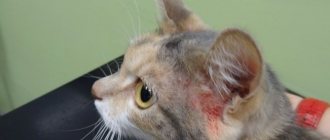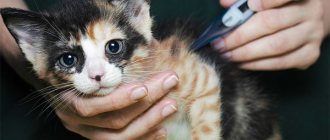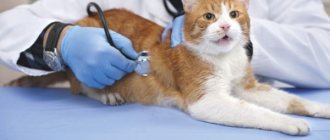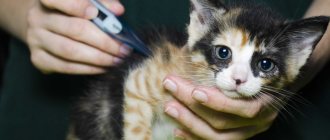Why is the temperature rising?
Healthy cats have:
The normal temperature is from +38 to +39 C, but for some breeds it may differ slightly. A temperature above 39 C is an alarming signal.
An increase in temperature may occur in the following cases:
Sometimes, in pregnant cats, the temperature, on the contrary, decreases. On average, this indicator becomes 2 degrees below normal. This can be observed several days before birth. In some cases, an increase in temperature may be one of the symptoms of cancer problems.
How to determine malaise?
The first signs of illness:
If these symptoms occur, it is recommended to take your cat to the veterinarian for examination and treatment. Often, owners may mistakenly mistake the onset of a serious illness for ordinary overheating.
To be sure that a cat has a normal body temperature, you should not rely only on general external signs. It is best to measure this indicator using appropriate devices. To do this, you can use a veterinary or medical thermometer. Any owner must be able to properly handle the device to most accurately determine temperature readings .
The end is lubricated with Vaseline or vegetable oil, then carefully inserted into the rectum, no deeper than 1.5 cm. The thermometer is held for about 5 minutes. Many owners prefer electronic thermometers, which need to be held for no more than a couple of seconds.
How to lower your cat's temperature at home yourself
When a cat develops a symptom such as a high temperature, the owner must understand that the help of a veterinarian in this case is simply irreplaceable.
However, if for some reason you cannot go to a veterinary clinic within a few hours, and the animal only gets worse, then there is only one rational solution - try to reduce the temperature at home.
You must act carefully, weighing the possible risks and benefits.
Combine diphenhydramine 0.3 ml with analgin 0.3 ml in one syringe and inject the cat intramuscularly into the hind leg. By analogy, you can use papaverine.
The best and safer option would be to wrap the animal in cool, damp gauze and take it to the clinic.
The content of the article
Instructions
To measure the body temperature of a small kitten, you will need a special veterinary thermometer. Although you can use a regular, familiar to everyone, “human” thermometer. It is better to give preference to an electronic thermometer. It measures temperature much faster than mercury. And the less time is spent on measurement, the less nervous the kitten will be.
Kittens' body temperature is usually measured rectally. It is unlikely that the baby will behave calmly when they try to insert a foreign object into his anus. Therefore, ask someone to help you with this difficult task; you will need to hold the animal while you take the measurement.
If the thermometer is mercury, shake it; if it is electronic, reset it to its previous value by pressing a certain button. Before measuring the temperature, lubricate the tip of the thermometer well with rich baby cream or Vaseline.
Place the kitten on your lap or place it on the table if the baby is calm. If the animal is nervous and breaks away from your hands, wrap it in a towel or sheet, leaving the back of the body free.
We suggest you read: Struvite in the urine of a cat: how to treat it
Lift the kitten's tail and very carefully, without causing pain to the baby, insert the thermometer into the rectal opening to a depth of 1-1.5 cm. Do this smoothly, using rotational movements. Talk to the kitten throughout the procedure, praise it, caress it. Such actions will help him calm down a little.
The kitten's temperature must be measured with a mercury thermometer for 5 minutes. At the end of the temperature measurement with an electronic thermometer, as a rule, a special signal is heard.
After taking your kitten's temperature, wash the thermometer thoroughly with soap and disinfect it with cologne or alcohol.
note
The normal body temperature for newborn kittens is 36.1°C, for babies older than a week – 37.8°C. In animals that ran a lot or were nervous before the measurement, their body temperature can normally reach 39.5°C, but not higher.
Traditional methods
The second stage of reducing the temperature will be drinking plenty of fluids, which will replace the fluid lost by the body and prevent dehydration. If a cat categorically refuses to drink, for his own good, water should be forced into his mouth. This should be done using a syringe (without a needle) or a rubber bulb, carefully, in small portions, but often.
In case of dehydration, which is accompanied by diarrhea, vomiting, and lack of urination, it is important to restore the salt balance.
You should not wet an animal’s fur, or give human medications as an antipyretic!
Interesting topics
- Protrusion of the third eyelid gland in cats and dogs
- 7 myths about cats
- The danger of polycystic disease in cats
- How to care for a pregnant cat?
- Why does a cat's teeth fall out?
- Features of keeping hairless cats
How to lower a cat's temperature?
Help can be provided using available tools. The easiest way is to slightly wet the animal's fur. The main thing is not to overdo it, so as not to disrupt the heat exchange process. For example, you can use a compress. To do this, gauze must be moistened with cool water and applied directly to the animal’s head. You can also completely wrap your cat in a damp towel. With this technique, it is important to prevent the animal from becoming hypothermic, especially if it is a kitten.
Reducing the cat's temperature by completely immersing the animal in a basin or any container with water is unacceptable. Dense wet fur will only make it more difficult to further restore normal thermoregulation. A damp towel will be enough.
It is also recommended to leave your pet in a cool room for a while. If it's winter outside, you can lower your cat's temperature by briefly opening the window. In summer, you can additionally use a fan. Another advantage will be maintaining an optimal level of humidity in the room. This is especially true if the cat has a viral infection. As a rule, it is difficult for her to breathe, and mucus is released profusely from her nose.
High temperatures can be reduced well by using pieces of ice. They can lower the temperature quite well. They need to be located in the following areas :
Animals with high temperatures also need to drink plenty of fluids, for which it is best to use cool water.
What temperature is considered normal for cats?
The temperature in cats, unlike in humans, is considered normal in the range from 37.8 to 39 degrees.
Higher values indicate a pathological process or overheating of the body. An increase in temperature cannot be ignored, as the cause may be a serious pathology. Normally, a cat’s body is designed in such a way that excess heat is eliminated naturally through the skin and respiratory system. If the pet is sick, then this process of thermoregulation is disrupted.
A cat's normal body temperature is ensured by the body's natural thermoregulation.
The cat has a fever: what to do at home
When stroking a pet, you feel that its body temperature is higher than that of a person. Exceeding a few degrees is considered normal. The average indicator covers parameters from 38 °C to 39 °C. An increase or decrease will signal the beginning of the development of inflammatory processes in the animal’s body. It is useful for owners to know what signs of pathological changes appear. It is recommended to be aware of what to do at home if your cat has a fever.
About the reasons for the rise in temperature
The appearance of such an unpleasant symptom in a cat as a high temperature can be associated with a variety of factors. Some of them are quite harmless, and some should force you to resort to prompt actions that will correct the pet’s condition and improve its well-being.
We suggest you read: How to calm your cat at night
So, a cat may develop a fever in the following cases:
- Stress and emotional overstrain - cats by their nature are extremely emotional and impressionable animals. A long separation from the owner, the arrival of a new pet in the house, as well as moving - all these moments have a particularly negative impact not only on the psychological, but also on the physical condition of the cat. The temperature does not rise significantly. The pet may experience food refusal, a depressed and lethargic state. Typically, such a disorder goes away on its own once the cause of the stress has been eliminated.
- Overheating is a problem faced by animals that often go out on their own. Prolonged lack of fluid, as well as exposure to direct sunlight, causes the body to begin to suffer from dehydration. Also, severe overheating can occur if you leave your pet in a hot car for a long time.
- Infectious disease - any illness of an infectious nature manifests itself with an increase in body temperature. Additionally, negative signs such as vomiting, lethargy, muscle weakness, loss of appetite, and indigestion appear.
- A viral disease significantly affects the condition of the cat. Any virus quickly affects the animal’s body. Additionally, a cough appears and mucus is released from the nose.
- Poisoning - intoxication of a pet’s body with low-quality food or household chemicals is manifested not only by fever, but also by severe vomiting, as well as a complete apathetic state. The animal also breathes heavily and constantly lies down.
Attention: sometimes temperature can indicate the presence of cancer. In this case, only a veterinarian can confirm or refute the diagnosis by conducting a complete diagnostic examination of the pet.
In most cases, a cat develops a low temperature due to hypothermia. But this is not the only reason. An animal may also suffer from hypothermia for other reasons. There are the following causes of low temperature in a cat:
- Peculiar infections and viruses that provoke low temperature because they destroy the pet’s immunity.
- General malaise and weakened body.
- Loss of appetite and weight loss.
- Consequences of anesthesia.
- Malignant tumors.
- Kidney disease, which occurs mainly in old age;
- Various injuries.
- Violation of metabolic processes. This happens due to a lack of a number of different vitamins and nutrients in the body. Symptoms of this type of disorder are: hair loss, slow growth, deformation of limbs, deterioration of claws, low temperature.
- Consequences after poisoning.
- Dehydration. After the body loses 10% of water, severe pathological changes occur. The following signs indicate that your cat does not have enough water: general weakness, dry mucous membranes - the mouth, nose and conjunctiva, as well as sunken eyeballs, low temperature.
- Enteritis is the general name for diseases that are characterized by inflammation of the intestinal epithelium. Most often, this disease occurs in young kittens, but it is also dangerous for adults if they have poor nutrition, terrible living conditions, or have experienced some kind of stress. In addition, the virus of this disease leaves the body along with feces and poses a threat to surrounding pets.
- Severe bleeding, both internal and external. Of course, external bleeding is easy to notice, but the presence of internal bleeding can only be guessed by stool or urine.
- Heart diseases. The symptoms of this type of disease directly depend on the type of disease. A mustachioed pet may exhibit arrhythmia, shortness of breath, or blue discoloration of the mucous membranes, and low temperature.
- Disease of the nervous system. In this case, the behavior of the animal changes radically. It becomes completely indifferent to various games and amusements.
A cat's high body temperature should not always be a reason to visit the veterinarian, since in certain cases this symptom does not indicate a serious illness in the pet. A cat’s temperature rises for the following reasons:
- 1. Normal body overheating. If an animal has been in a stuffy, enclosed room or exposed to direct sunlight for a long time, overheating occurs.
- 2. Stress recently experienced by the pet. A long separation from the owner, moving, a sudden change of environment, visiting a veterinary clinic and participating in an exhibition - all these events are stressful for a cat.
- 3. Increased physical activity.
- 4. Eating food. During a meal, the cat's temperature rises, and this phenomenon is normal.
It is worth sounding the alarm in cases where the temperature rises due to the occurrence of a certain disease in the cat. As a rule, this symptom indicates that the pet has one of the following ailments:
- infectious disease;
- various poisonings;
- malignant tumor;
- viral infection of the body;
- failure of the endocrine system;
- serious metabolic disorder.
Normally, it is 38-39 degrees in adult cats and cats, and slightly higher in young animals. Representatives of the Sphynx breed have a higher body temperature than other animals. It is normally 41-42 degrees.
So, why might pets have an elevated body temperature? Here are the most common reasons for this phenomenon:
- Normal overheating. When a pet stays in the sun for a long time or in a too hot room, car, train, the body temperature can rise above 41 degrees. In such situations, it is recommended to move the animal to a cool room, give it cold water to drink, and place it on the floor. Usually after an hour or two the cat returns to normal and perks up.
- Infectious and viral diseases. If your pet also experiences weakness, decreased urination, and vomiting, then most likely an infection has been contracted. The body will fight the infectious disease, including an increase in body temperature. The body reacts similarly to viruses, only in this case your child will sneeze and may experience watery eyes and nasal discharge.
- Stress, emotional shock. There are breeds of animals that are strongly attached to their owners. Their long-term absence in cats causes severe stress, which can also manifest itself as an increase in temperature. This sometimes happens after visiting exhibitions, moving, or the death of the owner.
- Active games, entertainment. Having run around and played enough, the animal overheats a little. But, having calmed down and rested, he returns to normal - everything stabilizes.
- Pregnancy. Due to physiological processes, the body temperature of expectant mothers can sometimes increase by one to one and a half degrees.
- Oncology. It develops more often in older cats. In such cases, it is very difficult to normalize blood counts, the functioning of internal organs and temperature.
We invite you to read: Solution for constipation in cats! Application of Vaseline oil.
Normal temperature in cats
In a healthy animal, body temperature during the day can vary from 37.4 °C to 39.5 °C. The exact indicators are individual for each pet, in addition, they are influenced by the characteristics of the breed. Owners should know the normal indicators for their cat in order to detect changes in a timely manner.
An elevated temperature in a domestic cat should alert any owner
For your information! For an adult porridge, an indicator of 39.4 °C will not cause any complications. But for a kitten this is a very serious symptom.
During the day the values will change:
Particular attention should be paid to small kittens. Their process of independent thermoregulation develops gradually. Therefore, the norm indicators for them will be different. Newborn kittens feel good in the range from 35.6 °C to 36.6 °C. Only at the age of 3-4 months do they reach adult parameters.
With age, metabolic processes in animals slow down just like in humans. Therefore, the body temperature will be below average. In pregnant females, on the contrary, the indicators increase.
Important! Cats with a small coat of fur will feel much hotter to the touch, since the distance between the palm and the animal's body is small.
Normal temperature readings in animals
How to reduce a cat's fever
If it turns out that your pet has an elevated temperature, action should be taken immediately. It is better, of course, to take the cat to the veterinarian. If this is not possible, the animal should be placed in a cool room and the air conditioning should be turned on. Lowering the ambient temperature by 18-19 degrees will improve the cat's heat transfer. There should be no drafts in the room!
The second stage of reducing the temperature will be drinking plenty of fluids, which will replace the fluid lost by the body and prevent dehydration. If a cat categorically refuses to drink, for his own good, water should be forced into his mouth. This should be done using a syringe (without a needle) or a rubber bulb, carefully, in small portions, but often.
In case of dehydration, which is accompanied by diarrhea, vomiting, and lack of urination, it is important to restore the salt balance.
The owner must provide the sick cat with the best possible care, comfortable living conditions, and a dietary diet. Food should be light and nutritious. The ideal option is chicken broth.
You should not wet an animal’s fur, or give human medications as an antipyretic!
Authors of the articles: Belanta Clinic team
Symptoms of fever in a cat
The pet will feel unwell at both low and high temperatures. An attentive owner will always notice that something is wrong with the pet; the cat has a high temperature. External signs may include:
Note! Veterinarians recommend that pet owners monitor their cat’s temperature for several days in a row. This is necessary to recognize it in normal condition.
If an animal has a low temperature, the condition will manifest itself with the following signs:
What to do if your cat has a temperature: rules for measuring it
Several types of thermometers can be used. If a contact device is selected, it must be individual for the animal.
Important! You need to use a mercury thermometer very carefully, as it can easily break.
Owners of active pets should pay attention to the following types of devices:
All tonometers, except the ear one, are intended for rectal use. It is important that the owner behaves calmly and does not raise his voice at the pet.
The procedure should be carried out as follows:
Important! The measurement result will be incorrect if the cat was constantly moving during the measurement.
The cat has a temperature of 40: reasons
If the cat's behavior has not changed, no one will think of taking his temperature. The very procedure of catching, fixing, and inserting a sensor into the anus can cause stress and a rise in temperature. Therefore, measurements are resorted to when additional symptoms are detected in a pet.
Taking into account the factors involved, febrile temperature should be considered dangerous to health when the excess of the norm is 1-2 degrees.
An increase in body temperature indicates an inflammatory process in the body. Sometimes it is recorded after surgery if the veterinarian recommends thermometry regardless of the pet's condition. However, most often hyperthermia is observed in infectious diseases or complications of chronic illnesses.
Be sure to read:
The cat has a swollen paw and is limping: what to do, main causes, first aid, treatment methods.
In this case, pay attention to the following additional symptoms:
- vomit;
- diarrhea;
- sneezing;
- cough;
- discharge from the nose and eyes.
Another cause of hyperthermia is heatstroke, which occurs when the cat is hot.
First aid at home before the doctor arrives
If the temperature increases slightly, there is no need to bring them down. The body must fight inflammation on its own. An increase indicates that protective mechanisms have come into play. It is necessary to take action if the value reaches 40-40.5 °C. You need to call a doctor and provide first aid to the animal. What to do at home if your kitten has a fever:
Important! Treating an animal with drugs that are used to reduce fever in humans is unacceptable, as this can cause allergies or impaired kidney function.
First aid at home
What can you do at home?
What to do if a cat has a fever and what measures should be taken first?
To begin, place the animal in the most comfortable place for it and do the following:
- Ventilate the room; the air in the room where the animal is located should be cool. Open the windows or turn on the air conditioner or fan.
- Give your cat a drink of Regidron solution if dehydration occurs.
- Cover your pet with a damp, cool towel.
- Offer your cat low-fat chicken broth.
- Do not wet your pet's fur - this creates a dense, impenetrable layer that interferes with normal thermoregulation.
- Provide your pet with peace.
Attention: the animal should not be forced to drink or eat. Forced drinking is only possible if the pet is dehydrated.
If the cat feels better after a while, then offer him low-fat food, for example, boiled chicken or fish.
A cat’s body temperature, which stays between 40-41 degrees, is critical, as it provokes severe loss of fluid, swelling of the respiratory tract, as well as the brain.
This condition of the pet requires immediate medical attention.
However, first you should try to reduce the temperature at least a little:
- Place an ice pack on your cat's inner thigh.
- Wet your animal's paws and belly with cool water.
- The cat must be force-fed cool water in small portions.
You should not give any antipyretics to your cat, even if they are intended for children. Medicines with excessively high thermometer readings can lead to the most unpleasant consequences and even the death of a pet.
The health of a domestic cat directly depends on the conditions in which it lives. However, no one can be immune from disease. This is why a cat’s body temperature may rise, despite high-quality care and excellent living conditions. Impaired heat transfer in cats occurs due to the influence of external and internal factors: stress, infection, simple overheating.
It is important to know that cats' body temperature is higher than that of humans. 37.8 is the optimal temperature for your pet.
Cat owners should know that the optimal temperature for their pet ranges from 37.5-39 degrees, which is much higher than that of humans. It is important to note that different breeds have different indicators as the norm. For example, for a sphinx the norm is 40 degrees, but for others this is already a signal of pathology.
We suggest you read: Sterilization of a cat, consequences of anesthesia and care after surgery
If the temperature rises slightly, it is not necessary to take any measures, but even this does not cancel a trip to the doctor. If your cat has a high fever, you can use echinacea tincture, which stimulates the body's defenses. There should be 1 ml of medicine per 1 kg of weight:
- The required amount of tincture should be mixed with boiled water (1 tbsp.).
- Draw the liquid into a syringe without a needle and forcefully give it to your pet.
- It is not recommended to use the product more than once a day.
Echinacea tincture stimulates the immune system
Additionally, you can use Regidron solution, which will replenish the fluid deficiency in your pet’s body and improve its well-being by preventing dehydration. 1 sachet needs to be filled with 1 liter of water and mixed thoroughly. The solution should be given 20 ml 3-4 times a day forcibly.
Rehydron replenishes fluid deficiency in the body
One day my cat got sick, which I identified by its characteristic signs. Kesha did not get up, and his nose was warm. In this case, due to lack of experience, I turned to my neighbor, an avid cat lover. In front of me, she measured the pet’s temperature by inserting a mercury thermometer into his anus. As it turned out, my pet had a fever, the cause of which was inflammation of the kidneys, which was clear from the animal sitting on the tray for a long time.
Traditional methods
To reduce your pet's temperature, you can use cool water to wet the animal's paws. However, you should never bathe a cat while sick. Cool water should be used not only externally, but also given to the pet internally using a syringe every few hours, 10-20 ml to prevent dangerous consequences.
If the temperature is close to 41 degrees, then it is recommended to wipe the cat’s paw pads with vodka or alcohol (it should be diluted half with water) every hour. For the same purposes, you can use 4% apple cider vinegar diluted with water 1:1. This procedure will ease the animal’s condition and help lower the temperature slightly.
Apple cider vinegar can be used to wipe your pet's paws
In extreme heat, you can apply ice wrapped in a towel to your pet's body, avoiding the abdominal area. This product should only be used urgently. It is not recommended to use it regularly. To alleviate your pet’s condition, you can turn on the air conditioning, but only to reduce the temperature in the room by a few degrees.
Medications
It is strictly forbidden to self-medicate in order to bring down a cat’s high fever. Ignoring the situation may lead to seizures.
Drugs can only be prescribed by a veterinarian after a complete diagnosis. Treatment should be aimed at eliminating the cause, and antipyretic tablets are given as part of complex therapy.
If the temperature reaches 40.5-41 °C, the cat is given a quarter of an analgin tablet. In case of pronounced chills and trembling of the body, the veterinarian makes intramuscular injections and injects drugs into the anus using an enema.
In especially severe cases, a mixture of analgin and diphenhydramine is prescribed per 1 kg of the cat’s weight. This is an undesirable measure; it is used only in extreme cases when it is necessary to urgently reduce performance.
Medication methods are applicable only after consultation with a doctor
Traditional methods
You can reduce your temperature using simple folk methods. To make the assistance as effective as possible, it is recommended:
If a kitten has a fever, no one usually knows what to do. Alternatively, you can use herbal infusions. For example, echinacea tincture has a good effect. It kills the virus and prevents the development of infection.
To obtain a solution, the tincture is diluted with water at the rate of 1 drop per day per 1 kg of animal weight. The solution is injected using a syringe. If the temperature does not decrease within 24 hours, it is necessary to show your pet to a doctor.
Echinacea as a remedy for fever
Normal indicators
The temperature in cats, unlike in humans, is considered normal in the range from 37.8 to 39 degrees. Higher values indicate a pathological process or overheating of the body. An increase in temperature cannot be ignored, as the cause may be a serious pathology.
Normally, a cat’s body is designed in such a way that excess heat is eliminated naturally through the skin and respiratory system. If the pet is sick, then this process of thermoregulation is disrupted.
A cat's normal body temperature is ensured by the body's natural thermoregulation.
The content of the article
A cat’s temperature, like that of any other creature, is one of the main indicators of health. An elevated body temperature can be a minor overheating condition or a serious symptom. It is very important to monitor the health of the animal, because the cat cannot tell about pain or discomfort.
Normally, a cat's temperature is 38-39 degrees. Kittens have a slightly higher body temperature than adult cats. Body temperature also depends on the time of year - in summer it is higher. Sphynx cats have a high body temperature. Normally it is 41-42 degrees. In other cases, the temperature increase may be due to the following reasons.
- Simple, banal overheating. If a cat is forced to spend some time in the sun, its body temperature can rise above 41 degrees. This can happen if the cat is locked in a stuffy room or while the animal is being transported. In this case, you need to move the cat to a cool place and give it water. Usually the temperature stabilizes within a few hours.
- Sometimes cats encounter infectious diseases. If your pet, in addition to a high temperature, experiences vomiting, weakness, lack of appetite, and decreased urination, this is a serious reason to contact a veterinarian.
- Cats also get sick from viral diseases. In this case, you may experience tearing, mucus from the nose, and sneezing. In case of viral diseases, it is important to ensure high humidity in the room and give the cat enough to drink.
- High temperature may be a consequence of emotional shock. Often cats show anxiety after visiting exhibitions, the veterinarian, after moving or losing their owner. In this case, calm the animal and, if possible, bring the cat into its usual habitat. Stress fever usually goes away quickly once everything is back to normal.
- Often the body temperature rises due to the animal's physical activity. But this increase is insignificant - no more than 1 degree.
- Sometimes body temperature increases in pregnant cats due to physiological processes.
- Often, a high temperature in a cat is associated with oncology, so wondering about the diagnosis and procrastinating is a crime. Show the animal to the veterinarian and make sure there are no irreversible processes.
But sometimes it happens that the whole point is in the incorrect measurement of the animal’s body temperature.
how to make a cat vomit at home
The cat's body temperature should be measured rectally. For this purpose, the pet is pre-swaddled. It would be nice if the procedure was carried out by two people - one holds the cat, and the second measures the temperature.
Lift the cat's tail and lubricate the anus with oil, Vaseline or cream. Lubricate the tip of the thermometer as well. It is best to use an electronic thermometer, as it works quickly and gives a signal immediately after the temperature measurement is completed. But if there is no such thermometer, you can use a regular mercury thermometer.
The tip is inserted 3-4 cm into the anus with circular movements and within 5 minutes you will know the exact body temperature of your pet.
So, the cat has been diagnosed with high body temperature. It is very important here to find out the true cause of hyperthermia and respond with immediate action.
- To begin, place the animal in a cool room. Open the windows in winter, and in summer, on the contrary, turn on the air conditioner or fan.
- Place wet rollers or ice wrapped in a towel on your inner thighs and behind your ears. You can cover the animal with a wet towel.
- Provide your cat with enough water to drink.
- If the situation is urgent, and you need to see a doctor only in the morning, you can smear the cat’s paw pads with alcohol, vodka or diluted vinegar every hour.
- Under no circumstances should you wet the animal. Wet fur will be a dense barrier to thermoregulation.
- Sometimes high temperatures can cause dehydration. Especially if it is accompanied by vomiting or diarrhea. When dehydrated, a cat behaves very lethargically, sleeps a lot, and does not urinate. In this case, it is very important to water the animal to restore the salt balance. Dissolve one sachet of Regidron in a liter of water. Offer your cat to drink this mixture. If she refuses, you need to force the solution in, because dehydration is very dangerous for the cat. Wrap the animal in a diaper and use a syringe without a needle to pour the solution into the mouth.
- Some points on the animal’s body are responsible for the course of life processes. To reduce the temperature, you need to do an acupuncture massage of a point located on the back paw. On the outside of the paw, under the knee bend, massage and press the skin, and within a minute you will notice that the temperature has begun to subside. But this method is only effective if the high temperature is caused by an infection.
- During periods of elevated body temperature, offer the animal dietary and light meals, mainly liquid ones. It is best if the cat laps up chicken broth.
- If you have a fever, you can give your cat echinacea tincture. It fights infection, strengthens the immune system, and suppresses the virus. Dissolve the tincture in a small amount of water at the rate of 1 drop per 1 kg of animal weight. Pour the prepared solution into the cat's mouth with a syringe.
We suggest you read: How to choose an aquarium or which aquarium is better
Remember, fever is a serious symptom. Even if you manage to knock it down, it is very important to see a veterinarian as soon as possible. Most likely, you need to fight not with temperature, but with the disease that caused hyperthermia. Take care of your animal, because it has no one to rely on except you.
how to remove fur from a cat's stomach
Having pets in the house is a big responsibility. But in addition to a good diet and leisure time for the furry pet, the owner must monitor the animal’s health. Cats, like other animals, sometimes experience troubles such as fever.
When sick, pets cannot say what hurts them or what caused the illness. The owner must take a responsible approach to ensuring a prosperous lifestyle for the pet. Loving owners always notice any deviation in the behavior of the animal, and can immediately determine that something is wrong with it. How to reduce a cat's fever at home? What should the owner know?
Healthy cats have:
- good appetite;
- shiny coat;
- wet, cold nose;
- uniform color of the mucous membranes - a uniform pink color (the shade may differ slightly in different individuals).
If a person's temperature is considered normal at 35.9 to 37.2 °C, then in a cat they are always higher - 38-39 degrees. There is an opinion that a temperature of 42 °C is considered normal for representatives of hairless breeds.
In fact, for Sphynxes it is the same as for long-haired cats. It's just that your pet's skin always feels hot when touched. It is not surprising, because there is no fur on it.
A slight increase in temperature in cats is always observed during the hot season. Indicators may vary throughout the day. So, during sleep and in the morning after waking up they are lower, but after physical activity, eating and in the late afternoon, on the contrary, they are increased. There's nothing wrong with that.
A temperature jump of 1 degree upward during estrus, pregnancy, childbirth, as well as after sterilization and vaccination should not cause concern.
It should be noted that in kittens the mechanism of thermoregulation is formed gradually. In newborns, the readings are considered normal: 35.5 to 36.5 ℃; in babies 1-2 months old, they range from 38.5 to 39.5 degrees. Once the kittens reach 7 months of age, the indicators stabilize.
An increase in body temperature in a pet can be caused by a variety of reasons. The most common of these is ordinary overheating. If the cat has been in the sun or in a stuffy room for a long time, the readings can jump up to 41 degrees.
To stabilize the temperature, it is enough to place the animal in a cool room and give it water to drink. As a rule, after a couple of hours thermoregulation returns to normal.
Temperature can also rise significantly due to stress. Cats are emotional, and the appearance of another pet in the house, moving to a new place of residence, changing or losing an owner, even a banal trip by car to the veterinary clinic causes them great anxiety.
The animal's condition will stabilize as soon as it feels that it is not in danger and its loving owner is still nearby.
Hyperthermia can be triggered by infections. In such cases, the pet experiences symptoms such as diarrhea, vomiting, urinary retention, lack of appetite, and weight loss. Infectious diseases are very dangerous and require immediate attention to a veterinarian.
If a cat's fever is accompanied by sneezing, mucous discharge from the nose, and watery eyes, it is most likely that the body is infected with a virus. In such cases, it is also necessary to visit a veterinary hospital.
The four-legged pet's temperature should be measured rectally with a thermometer. It makes no sense to measure under the paw, since all animals have hair, and the result will be incorrect.
Massage and diet
During periods of high fever, the animal must be fed only dietary food. You cannot overfeed or force it. The main thing is that the cat drinks as much water as possible.
Note! Food should only be liquid, for example, you can offer your pet low-fat chicken broth.
Vitamin C must be added to the diet to improve immunity. It helps the body fight inflammation. During illness, you can give your cat a mixture of yogurt, ascorbic acid and cottage cheese. Adults are given up to 500 mg of ascorbic acid per day.
Massage has a positive effect on reducing temperature. You need to knead the point under the knee bend on the outside of the hind leg for two minutes. Then you can lightly massage your entire body. The main objective of the procedure is to enhance blood activation. This will help speed up the healing process.
When to contact a veterinarian
Cats have two borderline conditions in which it is important to immediately take emergency measures. Temperatures above 40.5 °C, accompanied by severe fever, can be fatal. If your pet is breathing frequently and showing signs of tachycardia, this can lead to:
Important! It should not be neglected if an elevated temperature is observed for three days. The animal should be taken to the veterinarian even if there are no additional symptoms.
If the increase progresses, the animal will require resuscitation measures that cannot be carried out at home.
Contacting a veterinarian
Prevention
Knowing the reasons why a cat’s temperature may rise, you can take preventive measures to avoid the development of complications. To minimize inflammatory processes and various pathologies, it is recommended to observe the following measures:
It is important for pet owners not to ignore the warning signs of fever. You cannot self-medicate, since first of all it is necessary to establish the reasons for the increase in indicators. To avoid the development of complications, when you notice the first signs of poor health in your pet, you need to take him to the veterinarian.
Source
What to do if your cat has a high fever
What to do if a cat has a temperature above normal - this question worries many people if their pet is sick. The temperature of healthy cats is significantly higher than that of humans. However, its increase signals a disease or disorder in the body.
If nothing is done, the cat may die; it is necessary to provide him with timely assistance. To do this, it is worth knowing what tablets should be given to your pet and how to alleviate his condition.
Causes of fever in a cat
A cat's normal temperature reaches 39 degrees. For some breeds these figures are even higher. For example, a hairless cat has a temperature of 40 degrees - a natural phenomenon. In a kitten, elevated temperatures are a common phenomenon, which is associated with the developing thermoregulation system and the activity of the baby.
When measuring degrees, the indicators are different if, for example, you measure them in different phases of activity. If the cat behaves normally, its health apparently has not worsened, the increase in temperature may be due to natural causes:
After castration, a cat’s temperature can rise within one degree, up to 40. If the value on the thermometer is closer to 41, then the cat must be urgently taken to the veterinarian to exclude serious complications.
A high temperature in a cat during pregnancy is associated with its “position”. Complex biochemical processes occur in the pet’s body that fluctuate in degrees. There is no need to panic if she feels well, is active and cheerful.
If a cat exhibits alarming symptoms (lethargy, lack of appetite, nervousness), then active action must be taken. The first thing you should do is measure your temperature.
For this, it is better to use a special veterinary device, but a regular mercury thermometer will also work.
There are different methods of measurement, but the rectal method is considered the most effective. If the temperature turns out to be very high, the pet should be urgently taken to the veterinary clinic. It is worth understanding that at 41.5 in a cat, pathological processes begin in the body, in some cases irreversible.
In cats, degrees increase with various diseases: systemic, viral, infectious. Such indicators also accompany internal bleeding and cancer. Therefore, timely assistance to your pet is vital.
How to measure a cat's temperature correctly
The four-legged pet's temperature should be measured rectally with a thermometer. It makes no sense to measure under the paw, since all animals have hair, and the result will be incorrect.
Many owners prefer to use an electronic thermometer as it is the safest. In this case, it is necessary to take into account the error of changes, which will be 0.1–0.5 ℃.
A regular mercury thermometer will give an accurate result, but it is very fragile and therefore unsafe. Therefore, it is advisable for cat lovers without experience to resort to the first option.
It is rare that a cat will not resist when trying to measure its temperature, so it is advisable to carry out the procedure, which is painless but slightly unpleasant, together. One person will hold the animal, the second will perform the manipulation.
Measuring a cat's temperature:
- Place your pet on a hard, horizontal surface, tummy down.
- Lubricate the tip of the thermometer with Vaseline oil.
- Lift the cat's tail, carefully, in a circular motion, insert the thermometer into the anus about 1 cm (for kittens - 0.5 cm).
- Hold the electronic thermometer until the beep sounds, and hold the mercury thermometer for at least 5 minutes.
- After the procedure, wipe the thermometer with alcohol.
You can take your cat's temperature with an infrared ear thermometer. The procedure is absolutely safe and painless, in addition, the device will show the result in a maximum of 10 seconds. However, if an animal has an inflammatory process in its ear, the results will be unreliable.
Inexperienced pet owners prefer to determine the cat's temperature by looking at the nose: if it is wet and cool, then everything is in order with the pet's health. But if the nose is dry, then this indicates poor health, including a possible increase in temperature.
You should not rely on this method, because a cat that has just woken up from sleep will always have a dry earlobe. But you can touch the ears. If the cat's temperature is above 41 degrees, then they will be hot.











